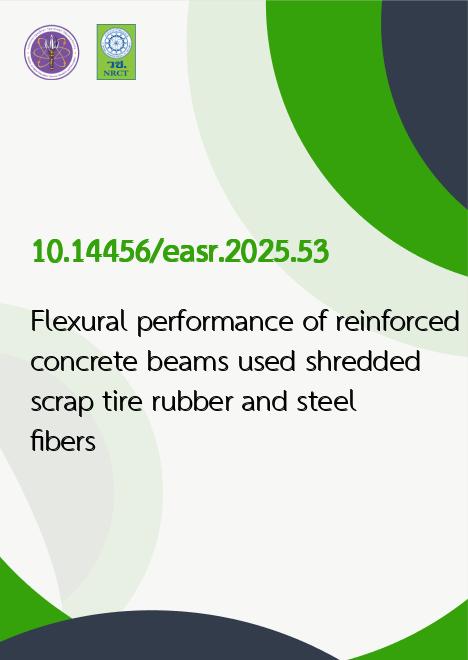
|
Flexural performance of reinforced concrete beams used shredded scrap tire rubber and steel fibers |
|---|---|
| รหัสดีโอไอ | |
| Creator | Wadhah M. Tawfeeq |
| Title | Flexural performance of reinforced concrete beams used shredded scrap tire rubber and steel fibers |
| Contributor | Taghreed Khaleefa Mohammed Ali, Ahmed W. Al Zand, Malik Al-Ajmi, Maha Al-Shaidi, George Jerinmon, Fatema Al Saidi |
| Publisher | Faculty of Engineering, Khon Kaen University |
| Publication Year | 2568 |
| Journal Title | Engineering and Applied Science Research |
| Journal Vol. | 52 |
| Journal No. | 6 |
| Page no. | 584-595 |
| Keyword | Tire waste, Compression strength, Beam, Displacement, Fiber |
| URL Website | https://ph01.tci-thaijo.org/index.php/easr/index |
| Website title | Engineering and Applied Science Research |
| ISSN | 2539-6161 |
| Abstract | This research experimentally investigates the flexural performance of fibrous reinforced concrete beams containing shredded scrap tire rubber (SSTR) as a substitute for gravel. Six reinforced concrete (RC) beams (1500 × 300 × 200 mm) were prepared with varying steel fibers (SF) (0%, 0.5%, 1%, and 1.5%) and SSTR (0%, 5%, 7.5%, and 10%) by volume of concrete. All samples were tested as simply supported beams under 3-point static loads. The RC beam with natural materials (0% SSTR and 0% SF) exhibited a typical crack propagation pattern, while the addition of 1% SF and 5% SSTR caused cracks to cease, resulting in ductile behavior. The optimal percentages were found to be 1% SF and 5% SSTR. The presence of SSTR reduced the compressive strength due to the impermeability of rubber, which helps absorb load energy, though SF additions improved this. Compressive strength reductions for 5%, 7.5%, and 10% SSTR were 15.37%, 11.64%, and 18.08%, respectively, compared to the control mix. However, the compressive strength of concrete containing 1% SF and 5% SSTR increased slightly by about 2.52%. Flexural strength of concrete prisms also decreased with higher SSTR content and varied SF dosages. Compared to the control mix, reductions in flexural strength for 0.5% SF with 5%, 7.5%, and 10% SSTR were 14.29%, 19.05%, and 19.05%, respectively. These reductions are due to the poor bond between SSTR and the cement matrix. The flexural performance of the reinforced concrete beam improved slightly by 1.71% for the B5 beam, which was made with 5% SSTR and 1% SF, accompanied by a slight increase in deflection (2.24%) and beam weight. The design ultimate loads from BS8110 were lower than the experimental values, with ratios of tested failure load to design ultimate load ranging from 1.99 to 2.78, the maximum ratio achieved by the B5 beam. |